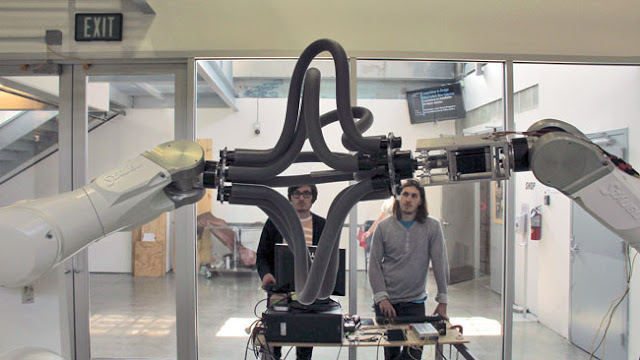Thursday, February 14, 2013
SCI-Arc Students Explore The Future Of Robotic Architecture
Architecture
| Accelerating The Southern California Institute of Architecture into the 21st Century the new SCI-Arc Robot House, initiated and designed by faculty members Peter Testa and Devyn Weiser, builds upon the school's strengths to create a next generation platform for experimentation and speculation on the future of architecture. |
The course explores robotic motion control as a creative medium for designers, mainly through the use of the custom robotic animation software platform, designed specifically for the SCI-Arc Robot House.
Accelerating SCI-Arc's pace, already at the leading edge of digital design and rapid prototyping, the new SCI-Arc Robot House, initiated and designed by faculty members Peter Testa and Devyn Weiser, builds upon the school's strengths to create a next generation platform for experimentation and speculation on the future of architecture.
Situated conceptually and physically between studio and shop, academy and industry, the double-height 1,000-square-foot Robot House is a research space for hands-on collaborative experimentation, advanced multi-robotic platform, and exploration and architectural agency. Exploring opportunities outside of traditional digital production, our six state-of-the-art Staübli robotic systems offer a new design environment which focuses on Institute-approved research and coursework.
Robot House is comprised of two main spaces. The Robot Room is where the five large Staubli robots are configured in a multi-robot work cell. Their layout empowers investigation with the widest range of interaction and process sequences possible in a simulation and programming environment.
Projects will explore additive free-form fabrication tied to advanced composite materials. The robots themselves support a reconfigurable 3D workspace with a wide range of applications including on-site construction.
The SCI-Arc Robot House offers a new design interface extending beyond a production facility. It creates unprecedented emulation, simulation and animation environments in which computational geometry, material agency and fabrication logistics merge. The introduction of video, vision and sensing technologies with the lab's robotic systems will support feedback and exchanges between matter, data and form.
The platform has the unique ability for the designer not only to design motion, but also to program, simulate, and speculate all at the same time. This type of animation space suspends the distinction between simulation, speculation, and ‘the real’, making it very hard for one to determine which is which while questioning traditional notions of architectural representation.
SOURCE SCI-Arc
| By kree8tiv | Subscribe to kree8tiv |
|
| |







No comments:
Post a Comment